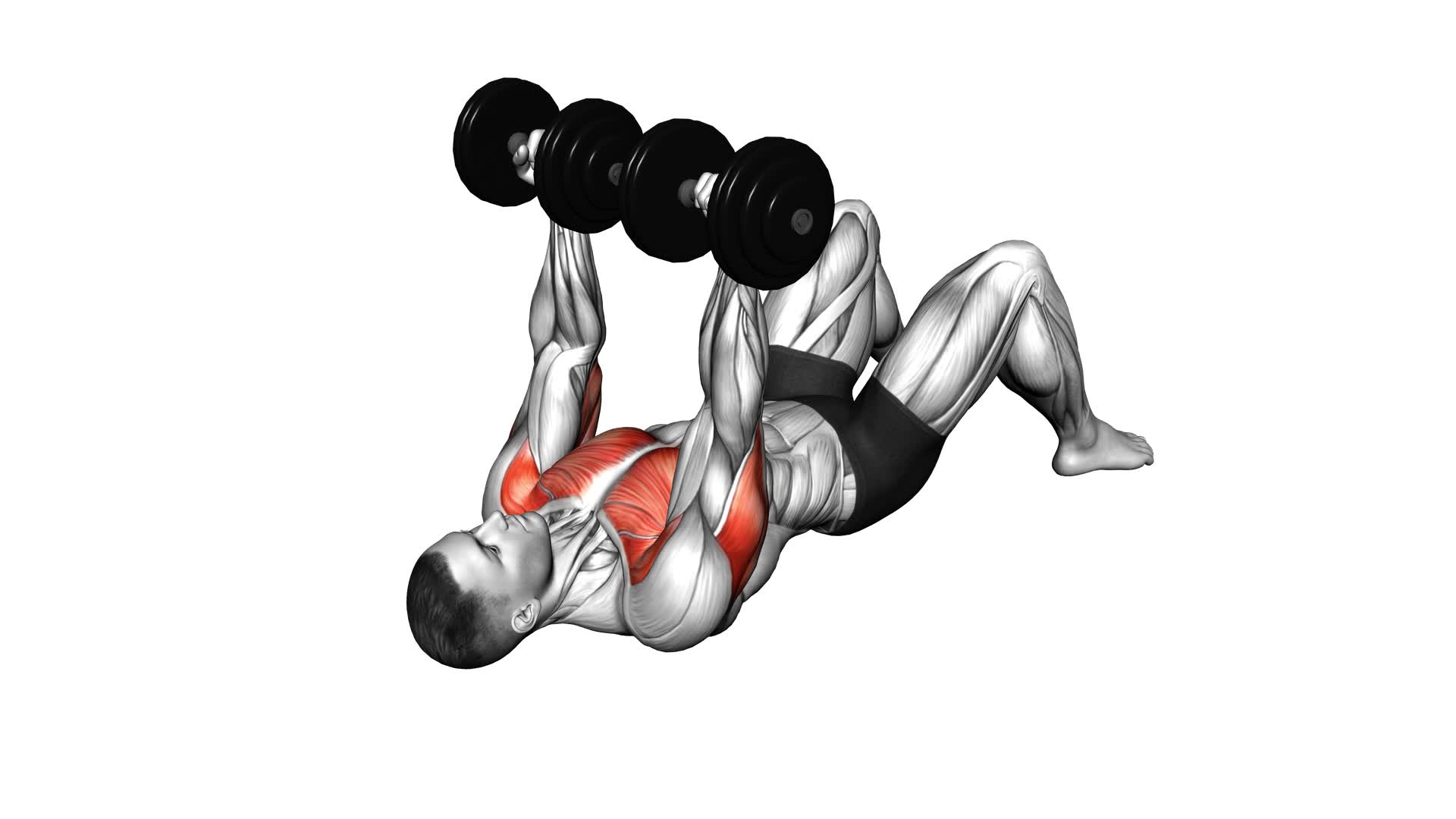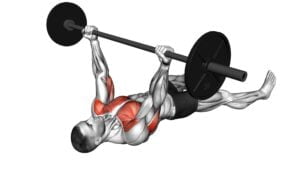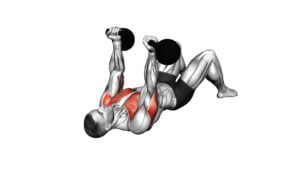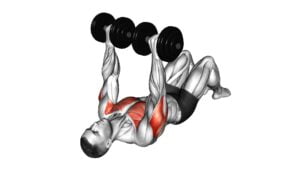Dumbbell Reverse Press on Floor – Video Exercise Guide & Tips

Are you looking to add a new and effective exercise to your routine? Look no further than the dumbbell reverse press on the floor.
Watch This Exercise Video
This exercise targets your chest, shoulders, and triceps, helping you build strength and definition.
In this video exercise guide, we'll walk you through the proper form and technique, offer variations to challenge yourself, and provide tips for beginners.
Don't miss out on this powerful workout – let's get started!
Key Takeaways
- Dumbbell Reverse Press on Floor increases upper body strength and targets the chest, shoulders, and triceps.
- It engages core muscles for stability and balance, promoting overall upper body strength and development.
- Proper technique involves maintaining a neutral spine, avoiding arching the back, and controlling the movement.
- Beginners can start with lighter weights or bodyweight and modifications can be made to suit individual fitness levels.
Benefits of the Dumbbell Reverse Press
What are the benefits of the Dumbbell Reverse Press for you?
The Dumbbell Reverse Press is an effective exercise that offers numerous benefits for your fitness routine. One of the key advantages of this exercise is its ability to activate multiple muscle groups. When performing the Dumbbell Reverse Press, you engage your chest, shoulders, and triceps, promoting overall upper body strength and development. Additionally, this exercise also targets your core muscles, promoting stability and balance. By incorporating the Dumbbell Reverse Press into your workout routine, you can enhance your muscle activation and improve your overall stability training.
Proper form and technique are crucial when performing the Dumbbell Reverse Press. To execute this exercise correctly, lie flat on the floor with your knees bent and feet planted firmly. Hold the dumbbells with an overhand grip, palms facing your feet. Begin by lowering the weights towards your chest, maintaining control and stability throughout the movement. Then, press the dumbbells back up to the starting position, ensuring that your arms are fully extended. Remember to engage your core and maintain a neutral spine throughout the exercise.
Proper Form and Technique
To perform the Dumbbell Reverse Press with proper form and technique, follow these steps:
- Lie flat on the floor with your knees bent and feet planted firmly.
- Keep your arms extended straight up, holding the dumbbells with an overhand grip.
Now, let's dive into the proper form and technique for this exercise:
- Maintain a neutral spine throughout the movement to avoid straining your lower back.
- Engage your core muscles by drawing your belly button towards your spine.
- Lower the dumbbells slowly and with control, bringing them towards your shoulders.
- Press the dumbbells back up to the starting position, fully extending your arms.
Now, let's address some common misconceptions about the Dumbbell Reverse Press.
One misconception is that you need heavy weights to make this exercise effective. However, focusing on proper form and engaging the right muscles is more important than the weight used.
Another misconception is that this exercise is only for advanced fitness levels. While it can be challenging, beginners can start with lighter weights or even just bodyweight until they feel comfortable progressing.
For advanced modifications, you can increase the difficulty by using heavier dumbbells, or even incorporating a stability ball or bench to elevate your upper body.
Remember to always listen to your body and modify the exercise as needed to ensure proper form and technique.
Variations to Challenge Yourself
To challenge yourself and add variety to your workout routine, try incorporating different variations of the Dumbbell Reverse Press.
By making advanced modifications and using different equipment options, you can take your workout to the next level.
One way to challenge yourself is by using heavier dumbbells. This will increase the resistance and help strengthen your muscles even more. Start with a weight that's challenging but still allows you to maintain proper form. As you get stronger, gradually increase the weight to continue challenging yourself.
Another variation is to perform the exercise on a stability ball. This will engage your core muscles even more as you stabilize yourself on the unstable surface. It also requires more balance and coordination, making it a great way to challenge yourself.
If you're looking for an even more advanced modification, try performing the Dumbbell Reverse Press on a Bosu ball. This won't only engage your core and challenge your balance, but it will also work your stabilizer muscles more intensely.
Incorporating different equipment options like resistance bands or kettlebells can also add variety to your workout and challenge your muscles in different ways. Experiment with different variations and equipment options to find what works best for you and keeps you motivated.
Tips for Beginners
If you're new to the Dumbbell Reverse Press, here are some tips to help you get started and ensure proper form:
- Start with lighter weights: As a beginner, it's important to focus on mastering the technique before increasing the weight. Begin with lighter dumbbells to allow your muscles to adapt and prevent injury.
- Maintain a neutral spine: One common misconception is that you should arch your back during this exercise. However, it's essential to keep your spine in a neutral position to protect your lower back. Engage your core muscles to maintain stability.
- Use a mirror or a spotter: It can be helpful to have a visual reference or a spotter to ensure you're performing the exercise correctly. They can provide feedback and help you make adjustments to your form.
- Modify the exercise if needed: Don't be afraid to make modifications to suit your fitness level. If the full Dumbbell Reverse Press is too challenging, you can start with a modified version, such as performing the exercise with your knees bent or using lighter weights.
Common Mistakes to Avoid
A common mistake to avoid when performing the Dumbbell Reverse Press on the floor is improper wrist alignment. Your wrists should be straight and in line with your forearms throughout the exercise. Avoid bending your wrists back or letting them collapse forward, as this can put unnecessary strain on the joints and increase the risk of injury. To maintain proper wrist alignment, focus on keeping a strong grip on the dumbbells and consciously engage the muscles in your forearms.
Another common mistake is using excessive weight. It's important to choose a weight that challenges you without sacrificing form. Using weights that are too heavy can lead to poor technique and increase the risk of injury. Start with lighter weights and gradually increase the load as your strength improves.
Additionally, rushing through the exercise is a mistake that many people make. The Dumbbell Reverse Press is a compound movement that requires control and precision. Take your time to perform the exercise with a slow and controlled tempo. This won't only maximize the effectiveness of the exercise, but also reduce the risk of injury.
Frequently Asked Questions
How Many Sets and Reps Should I Do for the Dumbbell Reverse Press?
For optimal results with the dumbbell reverse press, you should aim for a rep range of 8-12. This will help you build strength and muscle in your chest and triceps.
However, the number of sets you should do can vary depending on your fitness level. Beginners may start with 2-3 sets, while more advanced individuals can do 3-4 sets.
Remember to choose weights that challenge you but still allow you to maintain proper form throughout the exercise.
Can I Perform the Dumbbell Reverse Press on a Bench Instead of the Floor?
Yes, you can perform the dumbbell reverse press on a bench instead of the floor. This exercise is versatile and can be modified to suit your preferences and equipment availability.
Performing the reverse press on a bench offers stability and allows for a greater range of motion. It targets your triceps, chest, and shoulders effectively.
Remember to maintain proper form and control throughout the exercise to reap the benefits of the dumbbell reverse press.
Is the Dumbbell Reverse Press Suitable for Individuals With Shoulder Injuries?
If you have shoulder injuries, it's important to modify your dumbbell workouts to avoid further damage. The dumbbell reverse press may not be suitable for you, as it puts strain on the shoulder joints. Instead, try shoulder-friendly exercises like lateral raises, front raises, or seated shoulder presses.
These exercises will help strengthen your shoulders without causing additional harm. Always consult with a healthcare professional before starting any new exercise routine.
Can I Incorporate the Dumbbell Reverse Press Into a Full-Body Workout Routine?
Yes, you can definitely incorporate the dumbbell reverse press into a full-body workout routine.
This exercise targets multiple muscle groups and can help improve your overall strength and stability.
However, if you have shoulder injuries, it's important to modify the exercise to avoid further strain or discomfort.
Consider using lighter weights or consulting with a fitness professional for alternative exercises that won't aggravate your shoulder.
Are There Any Alternative Exercises That Target the Same Muscle Groups as the Dumbbell Reverse Press?
There are several alternative exercises that target the same muscle groups as the dumbbell reverse press. These exercises include the overhead press, push-ups, and the bench press.
The overhead press works your shoulders, triceps, and upper back, while push-ups engage your chest, shoulders, triceps, and core.
The bench press primarily targets your chest, shoulders, and triceps.
Incorporating these alternative exercises into your routine can provide variety and help you achieve balanced muscle development.
Conclusion
In conclusion, the dumbbell reverse press is an effective exercise for targeting the chest, shoulders, and triceps. By following proper form and technique, you can maximize the benefits of this exercise.
Additionally, incorporating variations and challenging yourself can help you progress and continue to see results. For beginners, it's important to start with lighter weights and focus on mastering the correct form.
Finally, be mindful of common mistakes to avoid to ensure a safe and effective workout.

Author
Years ago, the spark of my life’s passion ignited in my mind the moment I stepped into the local gym for the first time. The inaugural bead of perspiration, the initial endeavor, the very first surge of endorphins, and a sense of pride that washed over me post-workout marked the beginning of my deep-seated interest in strength sports, fitness, and sports nutrition. This very curiosity blossomed rapidly into a profound fascination, propelling me to earn a Master’s degree in Physical Education from the Academy of Physical Education in Krakow, followed by a Sports Manager diploma from the Jagiellonian University. My journey of growth led me to gain more specialized qualifications, such as being a certified personal trainer with a focus on sports dietetics, a lifeguard, and an instructor for wellness and corrective gymnastics. Theoretical knowledge paired seamlessly with practical experience, reinforcing my belief that the transformation of individuals under my guidance was also a reflection of my personal growth. This belief holds true even today. Each day, I strive to push the boundaries and explore new realms. These realms gently elevate me to greater heights. The unique combination of passion for my field and the continuous quest for growth fuels my drive to break new ground.







